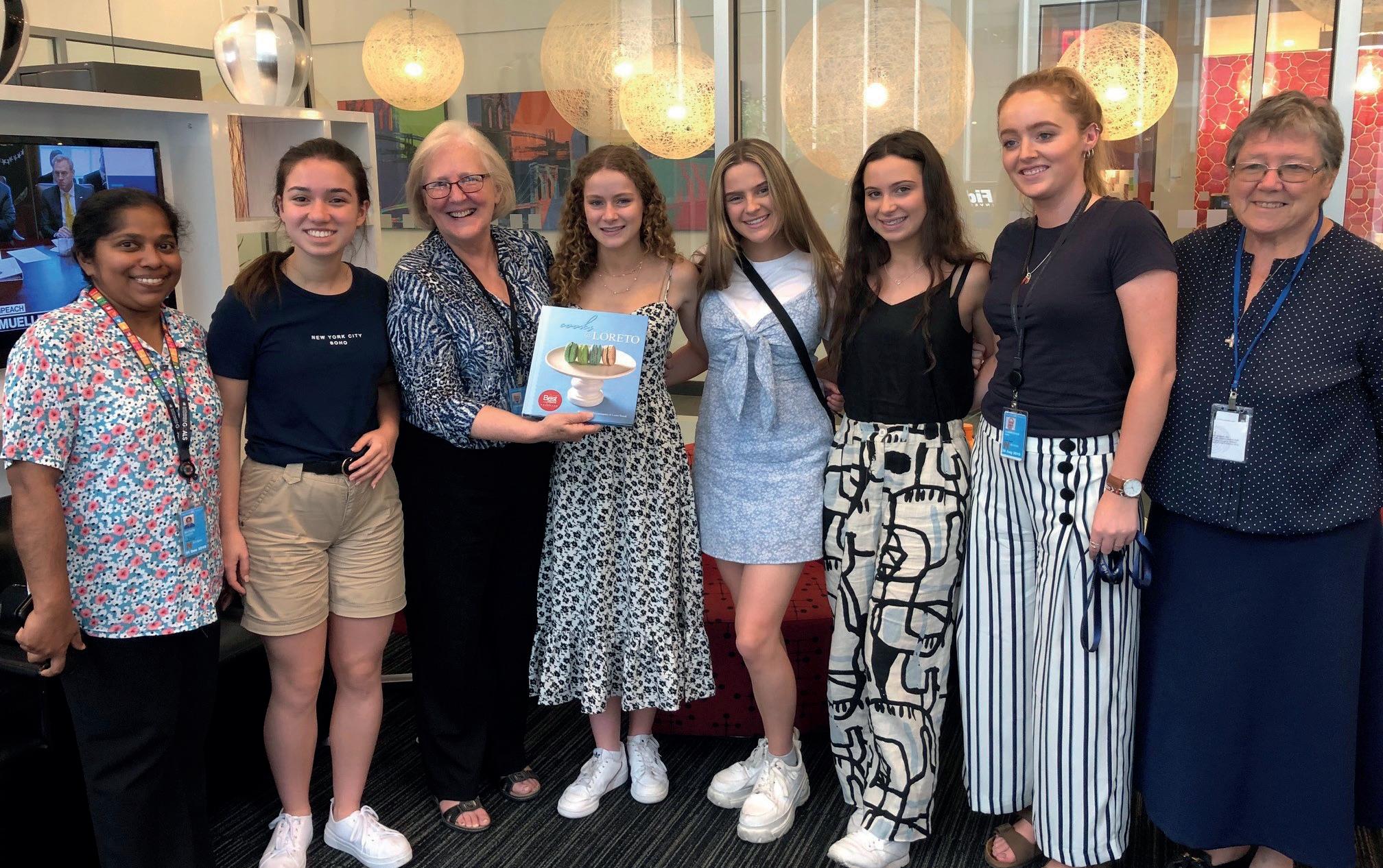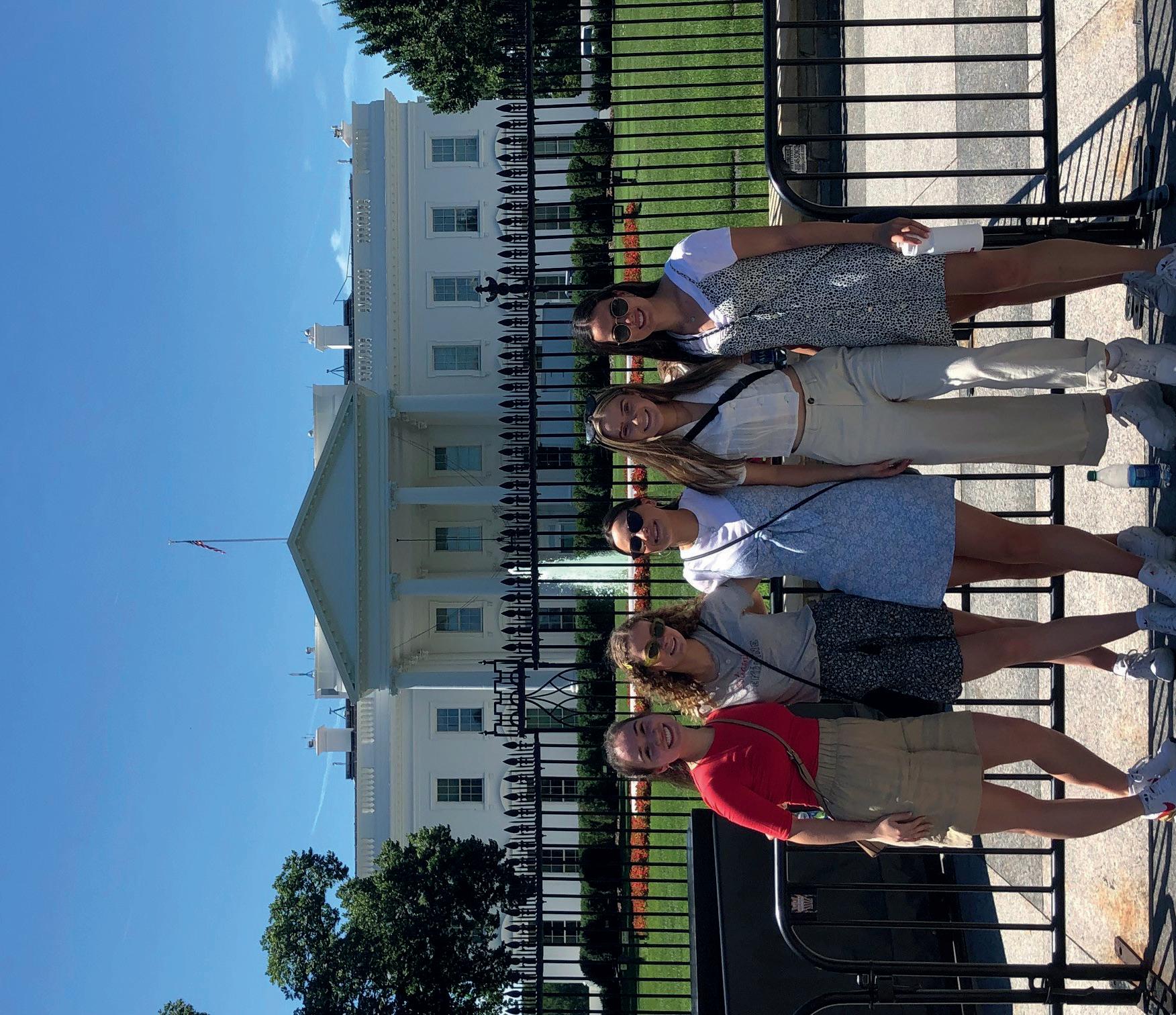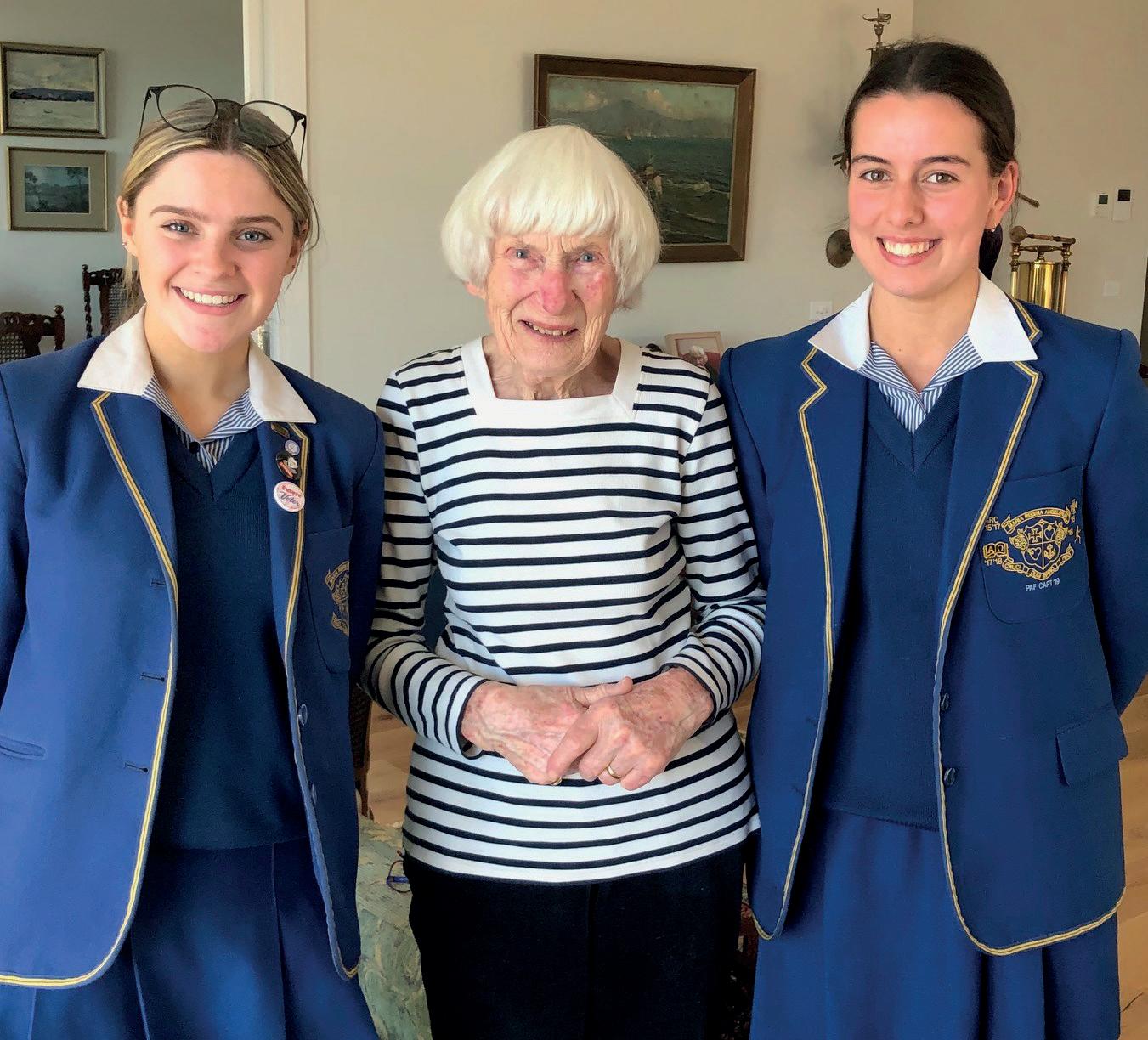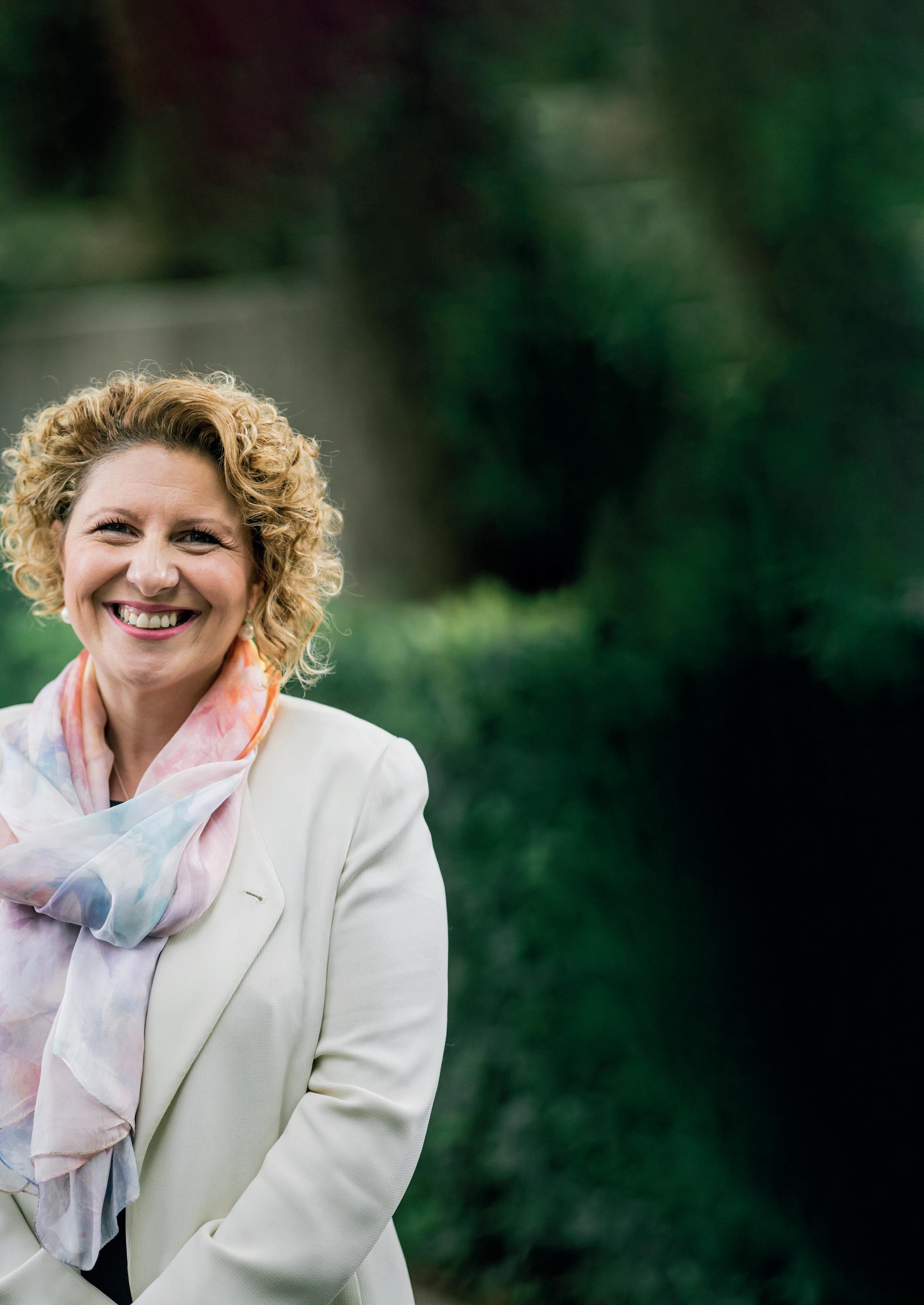
17 minute read
Global Young Leaders Conference
Global Young Leaders Conference United Nations Sustainable Development Goals
Loreto Toorak’s participation in the Global Young Leaders Conference was made possible by the extraordinarily generous support of alumna Mrs Rita André (O’Sullevan, 1941), in honour of her sister Miss Dora O’Sullevan. Mrs André’s belief in the capacity of Loreto women to do great things, encouraged her commitment to support strong leadership both at school and later in life. Enabling Loreto Toorak students to attend this conference is indeed an outstanding measure of her commitment.
In July 2019, a group of five Year 11 students from Loreto Toorak took part in the Global Young Leaders Conference (GYLC); a leadership and politics program involving student delegates from around the world with a focus on the United Nations Sustainable Development Goals. The conference administered by Envision Education, took place in Washington DC and New York City, USA. Our experience began with a cultural immersion in Washington. From the minute we stepped foot into the GYLC with 300 other scholars from all over the world, we were divided into working assemblies or country groups of 20 scholars. Although it was in our country groups that we spent most of our time debating,
discussing and listening to others, we were grateful to have the companionship of the other Loreto Toorak girls for an excitable chat about the daily stories and experiences we encountered. As we began discussions on international diplomacy and relations, leadership, cross cultural communication and progress for all nations with people from all over the world in our country groups, we shifted our focus to a task that became our main activity at the conference. Within our country groups we discussed the United Nations Sustainable Development Goals which address the global challenges the world faces, and a blueprint to achieve a better and more sustainable future for all, including clean water and sanitation, zero hunger, no
poverty and gender equality. We were tasked to represent the interests of a country based on our Sustainable Development Goal and propose tangible ways to improve upon this goal by 2030. The vigorous drafting, planning and researching began with the hope to have an effective proposal that could be presented at the Global Summit, where all 300 scholars attended a mock UN Bill Passing which simulated the works of the United Nations. Our visit to the United States Holocaust Museum was an extraordinary experience, which we reflected on in small groups following our encounter. Coincidentally, my group included a German student as well as a Jewish student from South Africa whose family fled Germany during World War II. It was eye opening to hear such different perspectives and emotions with questions sparking immense disagreement between the two boys. It made me realise that although we consider other people’s point of view, it is incredibly beneficial to hear rich discussion on an issue that did not occur during any of our lifetimes, but still impacts people in the world today. Another memorable experience was when we analysed a press statement from the US State Department which contained advice to citizens when travelling to Somalia. We took part in a mock press conference where some members acted as representatives from the State Department, and others posed as members of the press. The ‘press’ asked us questions about the statement, and we had to defend it even if we didn’t agree with it, similar to a debate. As it can in real life, the press conference got pretty heated with the media heckling us for answers. Outside of our Conference commitments, we had the pleasure of visiting some amazing parts of Washington, including some of the Smithsonian Museums, the White House, and Georgetown. In New York, we visited Times Square, Central Park, and saw the Statue of Liberty from the Hudson River on a cruise on our last night. A personal favourite was the Met Museum which was a special moment as we saw artwork from Ancient Egypt, Native Americans, and the Notes on Camp exhibition from the Met Gala.


We were also fortunate to visit the United Nations Headquarters in New York, and go on a tour where we learnt about the work of the United Nations, and saw the General Assembly and the Security Council. Because we had just spent 10 days looking at the United Nations’ Sustainable Development Goals and taking part in a mock summit, it was surreal to see the actual place where countries meet to work towards a more equal and peaceful future. At the conclusion of our trip, we visited Sr Cecilia O’Dwyer ibvm, an Irish Loreto Sister who works for the United Nations. We learnt about how the Loreto Sisters advise the United Nations’ policy on issues such as education and human trafficking, and realised how influential the Loreto community is on a global scale. It was amazing to see first-hand the work of the Loreto Sisters, and how it reflects the values we have back home in Melbourne. A lot of the lessons we learnt were not from the speakers we heard, but were from the other teenagers on the trip with whom we became friends. From talking to students from countries like Argentina, Egypt, South Africa, America, Barbados, and even other Australians, we learnt a lot about the importance of diversity. Most of the people we met came from different countries, cultures, religions, and whose first language wasn’t the same as ours. Getting to know these people, we saw the world from different perspectives, heard opinions different to our own, and learnt about what life is like for teenagers all around the world. Each person had a story to share and a lesson to pass on. During the space of 10 days, we all became extremely close, and by the end it felt like saying goodbye to a friend. This experience not only strengthened our friendships among our Loreto Toorak group, but also gave us the opportunity to make connections with people all around the world. We are honoured to have participated in such a rewarding and life changing experience, and one we would encourage to students with interests in politics, international relations and current affairs.
Opposite: Sr Cynthia Mathew CJ, Alessandra Negline, Sr Cecilia O’Dwyer ibvm, Millicent Walker, Bridie Collins, Marietta Stents, Isobel Cunningham (UN Youth Representative), Sr Kathryn Keigher ibvm Above: Bridie Collins and Mia O’Callaghan with donor Mrs Rita André Left: Alessandra Negline, Millicent Walker, Marietta Stents, Bridie Collins and Mia O’Callaghan at the White House.
Inner and Outer Landscapes Pilgrimage to the Lands of Mary Ward
It was an honour and privilege to represent Loreto Toorak on the Mary Ward Pilgrimage in May this year; a pilgrimage which retraced the steps of our Foundress, and a spiritual journey into the heart of the Mary Ward story.
Whilst I have been blessed with many memorable experiences during my time at Loreto Toorak as a student, parent and staff member, I believe this experience to be one of the best. As a group of 20 pilgrims from the Province Office and Loreto schools from around Australia, we visited the UK and Europe including York, London, St Omer (France), Liege (Belgium) and Munich; all of which were key places in the life of Mary Ward

and the development of her institute. Our tour group was led by Sr Sandra Perrett ibvm and Anne Muirhead, Director of Mission, Loreto Ministries. On our journey, we were warmly welcomed by other Mary Ward Sisters and supporters who invited us into their communities and towns like family members. The friendly embrace and generous hospitality from our extended community reminded us all that we are united by the Mary Ward tradition, linked by her charism and vision. Whilst the development of her institute took varied pathways over the centuries, the essence of its foundation and formation was consistent. Indeed, pondering my learnings from the pilgrimage, there were several key aspects of the experience that resonated with me. In many ways I believe that this pilgrimage, as the name suggests, required all those on the journey to reflect on the facts of time, place and context at a much deeper, spiritual level, appreciating the circumstances and challenges of the time and awareness of the purpose and vision that motivated and inspired Mary Ward and her companions. Mary Ward (1585-1645) lived during a time of great turmoil for Catholics in Reformation England. She endured three failed journeys to Rome, by foot, to gain the Church’s approval for her institute, imprisonment and persecution from English protestants for being Catholic, and from the Roman Catholic Church, criticism for being a member of a religious order working in the community and wanting to educate young women. Yet through all this, Mary Ward’s conviction was resolute. She had a deep and resounding faith, unwavering principles and a strong sense of purpose. She was a woman of intellect, compassion, sincerity and integrity.
Mary (Ward) made the greater part of the journey on foot, and with inconvenience such as may be imagined, in having but one pair of shoes for the journey which did not fit her, as they were for use of person’s with very different stature. – Winefrid Wigmore

Given the number of companions and supporters Mary attracted, it appears she was a most influential, charismatic faith-filled person. She must have had a disposition that was inclusive, engaging, sincere and earnest. Whilst she struggled during part of her life to truly understand the purpose and direction to which she was called, when she did indeed come to this realisation, she made her intentions clear and visible so that others were keen to follow. Over 400 years later with more than 200 Mary Ward schools and institutions worldwide, many accept Mary Ward’s vision, embracing her charism in their work and in their lives. So strong was this charism that much of the development and growth of the institute came after Mary Ward’s life. As a pilgrim, walking in the historical footsteps of Mary Ward, we were able to discern her story at a much deeper level and appreciate her life and legacy. As a teacher and leader within the Mary Ward tradition, I am evermore aware of my role to educate in this dynamic and evolved world landscape. I also see it as my responsibility to empower our girls to be well informed, discerning, compassionate women, showing empathy and a generosity of heart, as well as developing in them a strong sense of self, staying steadfast and true to what they know is just and right. Indeed, our Mission Statement calls us to embrace Mary Ward’s charism of love of Jesus, freedom, justice, sincerity, verity and felicity as part of our inheritance. It can be seen as our resource for the future; informing and guiding our reflection, our decisions and our actions. As Mary Ward said, “I hope in God it will be seen that women in time to come will do much.”
Above: Catherine Maimone Crowhurst pictured with Mary Ward’s tombstone, inscribed with the words; “To love the poor, persevere in the same, live, die and rise with them was all the aim of Mary Ward who lived 60 years and eight days and died on 20 January, 1645* (*Old style calendar: new style 30 January).
We celebrate Mike Mulcahy’s contribution to Loreto Toorak as he retires after 40 years of service.
Mike accepted the position in 1980, teaching Mathematics, Science, Religious Education and Biology. Throughout his career, Mike held several positions of leadership, appointed to Year Coordinator in 1987, continuing with this year level for 14 years. A proud Mulhall man, Mike was twice appointed Head of Mulhall House, and contributed to the competition and spirit of House activities. Mike worked actively in matters of social justice, including as teacher-in-charge of the Turana program for social engagement and reform for disengaged youth. Involved in the broader life of the School, Mike contributed to the Consultative Committee and the Staff Association, bringing his wisdom and a sense of building community. Mike will be missed by his students and colleagues alike. His sense of fun, genuine warmth and sincerity, and his modelling of justice in his everyday actions and work are valued attributes. As we wish him well for his future, we do so with appreciation for the gift of his working life to our wonderful school.
What motivated you to stay at Loreto Toorak for so long? The wonderful people and the great sense of community and consequential happiness that I have experienced. Sr Deirdre Rofe employed me during her first year as Principal in 1979, and I discovered a thriving convent of Loreto nuns and a convivial teaching staff. There was a clear sense of academic rigour but the Loreto values were also very apparent. The students were respectful, kind and considerate. Sr Deirdre became my great advocate and mentor as a developing young teacher and I learnt a lot from her as well as the nuns who were part of the community. Strong and enduring friendships developed with staff who stayed the distance of time like me; Andrew Schmidt, Roger Gill, Joan Ryan, Amanda Apthorpe, Alon Kaiser, Kim Hauser, Sandra Jane, Felicity Ferdinands and of course, Rosemary too. Once I realised I was starting to teach the daughters of girls I had previously taught, I knew that the passage of time at Loreto Toorak had become considerable. What are some special memories or highlights of your time here? The whole school Pilgrimage to Central Australia in the Bicentenary of 1988 proved to be a unique and hugely successful event for all concerned. No other PAF in 40 years has been performed in the same way as it was at the Yulara Resort amphitheatre. What are the most significant changes you have seen? Like most aspects of life in recent decades, teaching has changed immensely and the advances in technology have significantly impacted on the profession. I think back to the days of fordigraphed sheets reeking of methylated spirits and the black inked exam sheets that Sr Susan Daily ran off from her Gestetner printer at a cracking pace. I developed a great fondness for overhead projectors. Personal computers appeared in the early 2000s and now they are the norm in classroom life with text books being replaced by e-books and access to the external world via the internet. How would your students and colleagues describe you? I hope they would see me as a well organised, competent and dedicated teacher who was sincere but also ready to share a joke. I hope my colleagues would view me as a caring and passionate member of this profession. I believe that service to others is an important personal attribute and I have tried to live this out in a variety of roles at our School over the years. What do you think you will be remembered most for? I hope I will be remembered fondly just as this place and its people will always be a significant and unforgettable part of my life journey.
After 32 years, Rosemary Abbott, Director of Library, has chosen to retire. We thank her for her contribution to Loreto Toorak.
As early as 1988, Dr Abbott’s work on the introduction of library management systems ensured a library that supported teaching and learning. From this beginning, the Library changed and developed to create a resource centre, both digital and print, that was utilised by both students and staff. Her leadership has ended with the magnificent Library now housed in the Mandeville Centre; a Library of international standard, with leading practice and processes. Dr Abbott has contributed through memberships of professional bodies and leadership of committees. Her work in the development of IT Library related programs is widely acknowledged. Her provision of quality resources and skills teaching, together with her establishment of literature to cater for all interests has been a hallmark of her work. Dr Abbott will be missed by many who will remember the strong, professional relationships she fostered, and her approachable demeanour. We farewell Dr Abbott with a sense of profound gratitude, as we wish her all the very best for her retirement.
What motivated you to stay at Loreto Toorak for so long? To work in a Mary Ward school, with the commitment to social justice and academic excellence, has been rewarding. It has been a great privilege to have made connections with the IBVM Sisters; women of intellect and integrity. I have been fortunate to have worked with some wonderful teachers; in particular, I acknowledge the loyalty and support of Kim Hauser over 27 years; and Rob Dernelley, former Director of Studies who began in the same year; we found our way together and became firm friends. I have worked with three remarkable Principals; Sr Deirdre Rofe, Dr Anne Hunt and Dr Susan Stevens. I have enjoyed many opportunities for professional growth, including attending and presenting at conferences. I am grateful for the support when I studied for my Masters and my PhD. I have also appreciated being involved in the early development of IT through the School. What are the most significant changes you have seen? The automation of library systems, the first use of the internet in the School, increasing use of digital technologies and resources, the Senior Library being replaced by the Mandeville Centre Library. Student learning is now very different from the ‘chalk and talk’ of my early years; it focuses around a sophisticated digital environment with the use of laptops and online curriculum. What are some special memories or highlights of your time here? The Bicentennial Pilgrimage to Central Australia in 1988 was a remarkable experience that created strong bonds with staff and students. Attending the 2015 Mary Ward Conference in Sydney, meeting IBVM Sisters from around the world was an positive and inspirational experience. The opening of the Mandeville Centre in 2015, an extraordinary new learning and working spaces, has given me an amazing space in which to work. How would your students and colleagues describe you? Students would say that I am caring and fair, and always available to assist them. I believe my colleagues would say that I am flexible and approachable, and that I do my very best to support the learning of all students. What do you think you will be remembered most for? I hope I will be remembered as someone who cares deeply about the School, particularly the students and their learning. I would like to hope that staff and students recognise the effort I have put into the Library being a welcoming hub of learning in the School and in building strong relationships with all who use the Library.
A Place of Historical Significance From our Director of Rathfarnham & ELC
Upon my return from the Mary Ward Pilgrimage I was delighted to see the completed outdoor area in front of Sr Toni Matha Hall.
This aesthetically beautiful, green, welcoming space is a wonderful addition to the Rathfarnham playground. We look forward to the foliage establishing itself and the canopy of beautiful Crepe Myrtles shading this glorious paved area, in which the girls can gather in welcoming and inclusive circle spaces during their break times. This area also lends itself to a tranquil, outdoor learning space. As many of you are aware, this area has historical significance for the School as it was in this place, that a huge Morton Bay Fig stood for over 120 years. This tree formed an important part of the school landscape since the School began and provided shade, shelter and sanctuary for generations of students.

Many of us remember playing in and around the tree, using our imaginations to create games and stories in which the tree was the central focus. Her sturdy, broad branches serviced us well for so long that in her honour we have named this newly created landscaped space ‘Figgy Grove’. We hope that this aptly named space reflects the fondness and affection we had for the tree and that this new area will in turn provide shade, shelter and sanctuary during the imaginative, fun games of our current and future generations of Rathfarnham girls.









